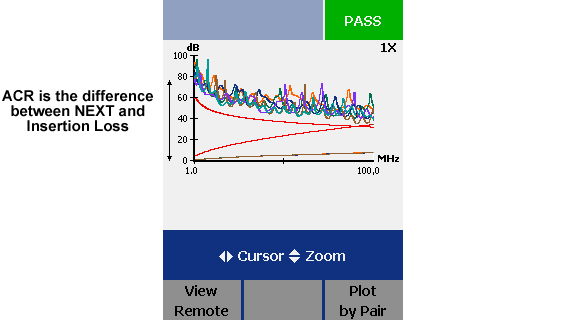減衰対近端漏話比 (ACR-N) - DTX CableAnalyzer
ACR was replaced with ACR-N when the standards renamed ELFEXT to ACR-F for consistency.
This is the difference between NEXT and the attenuation for the pair in the link under test. Due to the effects of attenuation, signals are at their weakest at the receiver end of the link. But this is also where NEXT is the strongest. Signals that survive attenuation must not get lost due to the effects of NEXT.
注記:TIA standards do not require ACR-N and PS ACR-N
So why does the DTX report ACR?
Many cabling vendors sell systems based on ACR-N performance. Customers therefore expect the test report to have ACR-N on it, so the DTX reports ACR-N.
What limit line does the DTX use if there is no ACR-N requirement?
The limit line is created using the ACR-N formula of NEXT- Attenuation. However, the DTX will not fail a link if the ACR-N exceeds the limit line, because it is not required for compliance. In reality, if ACR should fail, either attenuation (insertion loss) or NEXT will have failed.
Using PS NEXT and attenuation, Power Sum ACR Near-End (PS ACR-N) can also be calculated. PS ACR-N is not required by ANSI/TIA-568-C.2. The DTX as with ACR-N will report it anyway.
During signal transmission over twisted pair cable, both attenuation and crosstalk are active simultaneously. The combined effect of these two parameters is a very good indicator of the real transmission quality of the link. This combined effect is characterized by the Attenuation-to-Crosstalk Ratio Near-End (ACR-N). ACR-N is nearly analogous to the definition of signal-to-noise ratio. (ACR-N excludes the effect of external noise that may impact the signal transmission.)
Results Interpretation ACR-N is an important figure of merit for twisted pair links. It provides a measure of how much 'headroom' is available, or how much stronger the signal is than the background noise. Thus, the greater the ACR-N, the better.

*This is a hybrid trace created for educational purposes only.
トラブルシューティングの推奨事項
ACR-N is derived from NEXT and attenuation data. Any steps taken to improve either NEXT or attenuation performance will improve ACR performance. In practice, this usually means troubleshooting for NEXT because the only way to significantly improve attenuation is to shorten the length of the cable.






